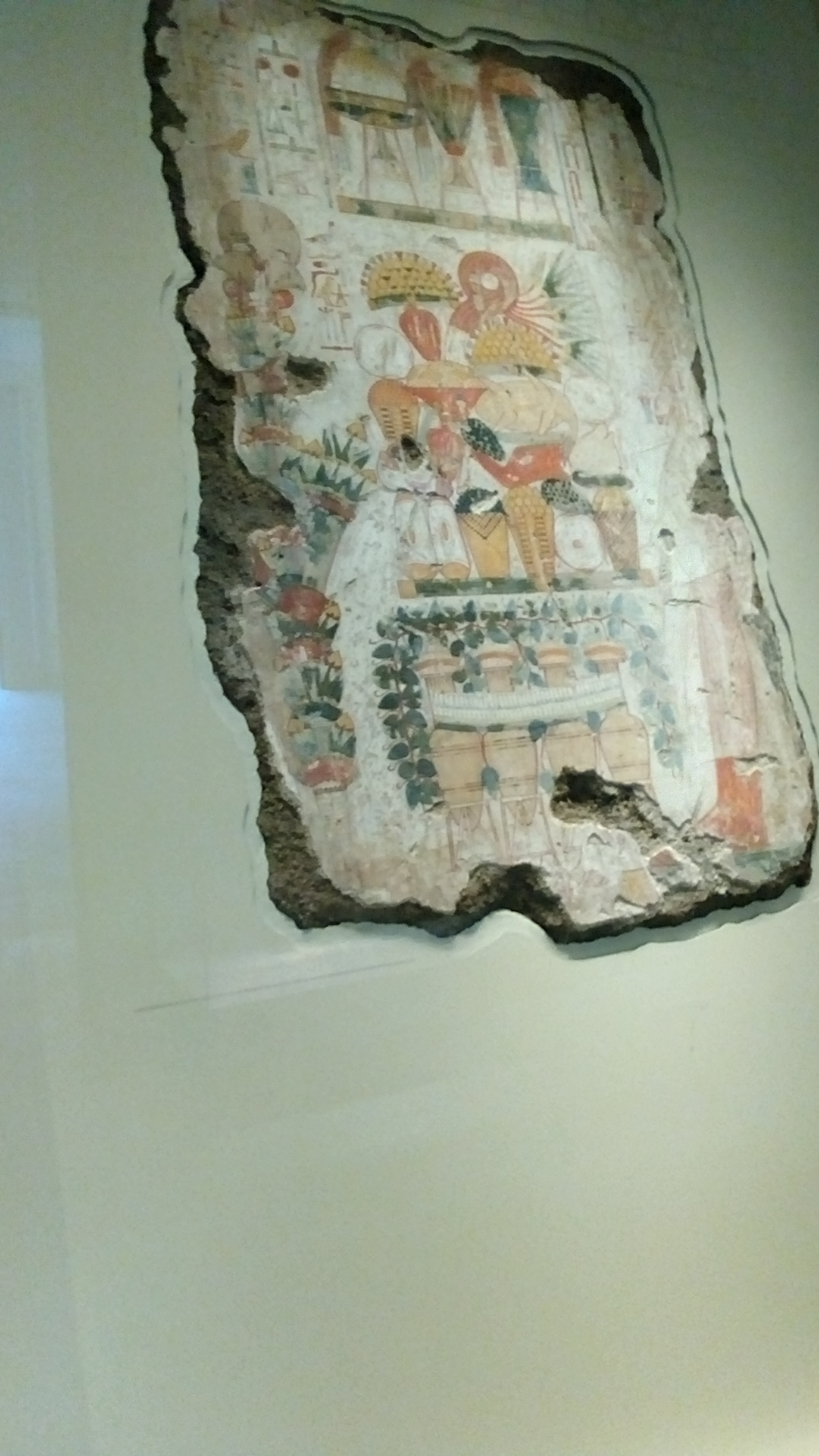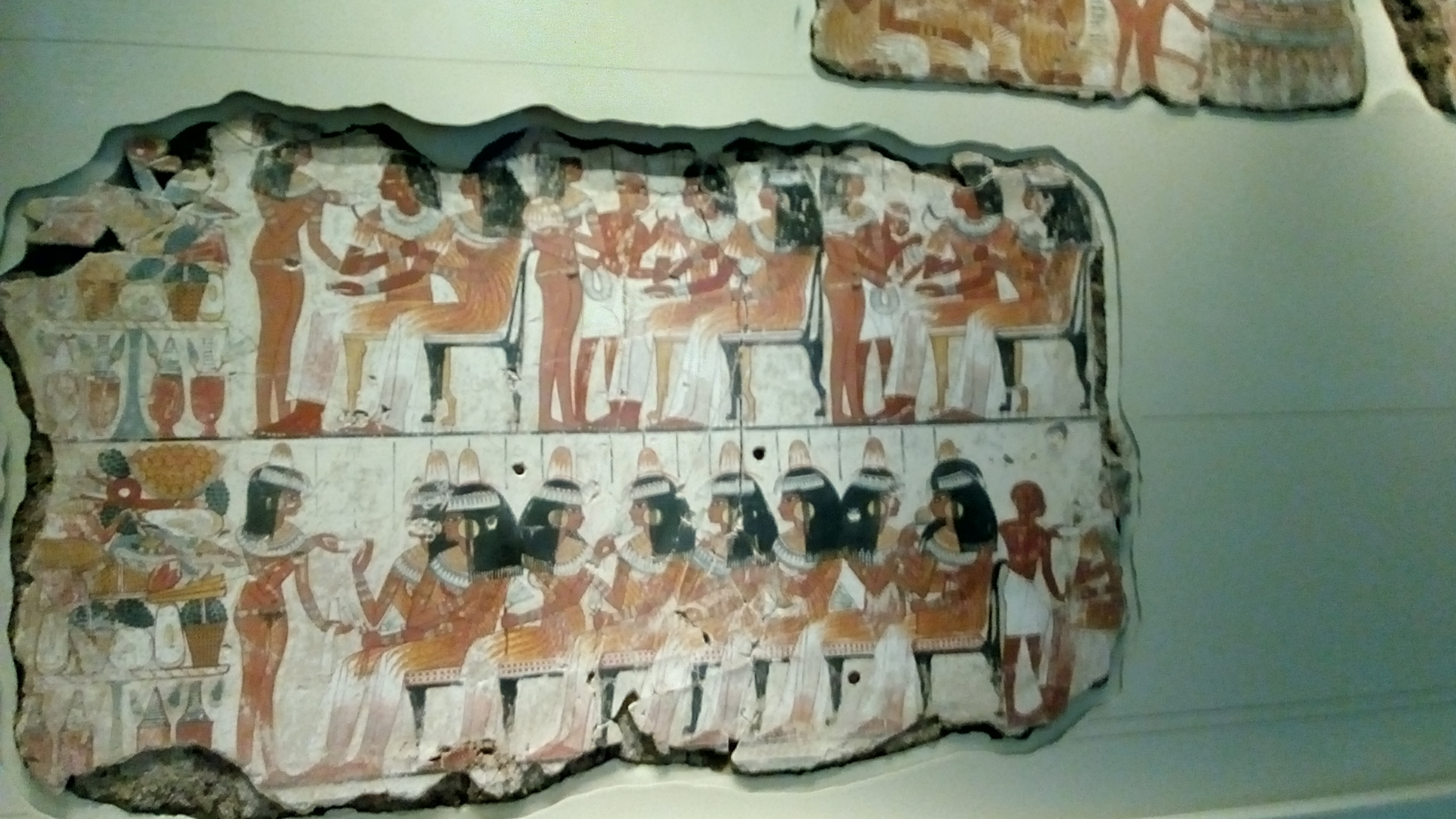Difference between revisions of "Tomb-chapel of Nebamun"
From Londonhua WIKI
(Created page with "=The Tomb-chapel of Nebamun= {{Infobox |title = The Tomb-chapel of Nebamun |header1 = Nebamun the accountant |bodystyle = width:25em |image = File:Nebamun.jpg|x450px|alt=...") |
|||
| (2 intermediate revisions by the same user not shown) | |||
| Line 16: | Line 16: | ||
|data5 = The [[British Museum]], London | |data5 = The [[British Museum]], London | ||
}} | }} | ||
| − | + | __TOC__ | |
| + | <br> | ||
| + | =Description= | ||
| + | The 11 wall paintings were found in the 1820's and eventually made their way to the British Museum. They have been on display since their debut back in 2009 and are considered the Museum's greatest treasures. | ||
| + | =Overview= | ||
| + | Nebamun was a rich accountant in the Temple of Amun at Thebes in 1350 BC. The chapel in his tomb was extraordinarily decorated with exquisite jewelry and furniture which he used to reflect how wealthy he wanted to be in his afterlife. However, this wealthy lifestyle was not what many common people could afford. The paintings and items in the tomb suggest that life in Ancient Egypt was difficult for the poor and uneducated and that they suffered greatly as labourers. | ||
| + | <br><br> | ||
| + | =Nebamun's Life= | ||
| + | In many of the wall murals, there are references to a Nebaman's wealth. Two images that have the most significance is the painting of the offerings for Nebamun and the image of his garden of the west. | ||
| + | ==Offerings for Nebamun== | ||
| + | This mural depicts a large pile of lavish food for Nebamun, his wife and his son with wine and exquisite decorated perfume jars. His son is pictured offering a tall basket of papyrus and flowers to the god Amun. | ||
| + | ==Garden of the West== | ||
| + | This image depicts what a wealthy person's garden, which is full of birds, blooming flowers and full trees, may look like in their life on earth. He wanted his afterlife garden to look just like his garden when he was alive. | ||
=The Opposite Lives of the Rich and the Poor= | =The Opposite Lives of the Rich and the Poor= | ||
| − | + | <br> | |
| − | = | + | ==Labourers' Lives== |
| − | + | Unlike Nebamun, who was an upper class individual, the lower class was unable to read or write so many of their experiences were lost with time. They were unable to afford lavish burial sights with extraordinary decorations and unfortunately the poor lived much shorter lives. | |
| − | Nebamun was the | ||
| − | |||
==Housing== | ==Housing== | ||
| − | Many people lived in villages near or along the rivers or in the river delta. They built mudbrick, wood and reed homes because those building materials were inexpensive and could be found locally. Since their homes where near the river and were not build from strong materials, many were washed away when floods occurred or would crumble after several years of use causing the families that lived their rebuild frequently. | + | The upper class of the time could build houses of the strongest materials available making it possible for them to have multi level homes. Most homes had at least 3 rooms, were stone and had windows. Their homes were more vibrant in colour with coulorful reed mast to provide shade, keeps flies out of the house and to walk on. Houses for the upper class were often built with a central court yard for a garden. |
| + | Many people lived in villages near or along the rivers or in the river delta. They built mudbrick, wood and reed homes because those building materials were inexpensive and could be found locally. Since their homes where near the river and were not build from strong materials, many were washed away when floods occurred or would crumble after several years of use causing the families that lived their rebuild frequently. The lower class' homes were windowless and had only one floor. | ||
<br><br> | <br><br> | ||
| − | |||
| − | |||
| − | |||
=References= | =References= | ||
1. The Egyptians - Housing. (2013, November 18). Retrieved May 10, 2017, from http://www.historyonthenet.com/the-egyptians-housing/ | 1. The Egyptians - Housing. (2013, November 18). Retrieved May 10, 2017, from http://www.historyonthenet.com/the-egyptians-housing/ | ||
<br> | <br> | ||
2. Middleton, Andrew, and Ken Uprichard. Egyptian Life and Death: The Tomb-chapel of Nebamun (Room 61). N.d. The Michael Cohen Gallery 1400 – 1300 BC. England, London. | 2. Middleton, Andrew, and Ken Uprichard. Egyptian Life and Death: The Tomb-chapel of Nebamun (Room 61). N.d. The Michael Cohen Gallery 1400 – 1300 BC. England, London. | ||
| + | 3. Dorment, R. (2017). The tomb-chapel of Nebamun at the British Museum, review. Telegraph.co.uk. Retrieved 10 May 2017, from http://www.telegraph.co.uk/journalists/richard-dorment/4290640/The-tomb-chapel-of-Nebamun-at-the-British-Museum-review.html | ||
<br><br> | <br><br> | ||
=Image Gallery= | =Image Gallery= | ||
| − | < | + | <gallery mode="packed"> |
| − | [[Category:Art]] | + | Image:offer.jpg|''Offerings for Nebamun'' |
| − | + | Image:garden.jpg|''Garden of the West'' | |
| − | [[Category:Philosophy & Religion]] | + | Image:serve.jpg|''Servants attending to Nebamun's Guests'' |
| − | + | Image:jewlery.jpg|''Jewelry found in Tomb'' | |
| + | </gallery> | ||
| + | [[Category:Art]] | ||
| + | [[Category:Philosophy & Religion]] | ||
Latest revision as of 21:48, 10 May 2017
The Tomb-chapel of Nebamun
 | |
| Nebamun the accountant | |
|---|---|
| ' | Attributed to Lauren Conroy |
| ' | c. 2014 |
| Dimensions | 55.2 cm × 43.8 cm ( 21 3⁄4 in × 17 1⁄4 in) |
| Location | The British Museum, London |
Contents
Description
The 11 wall paintings were found in the 1820's and eventually made their way to the British Museum. They have been on display since their debut back in 2009 and are considered the Museum's greatest treasures.
Overview
Nebamun was a rich accountant in the Temple of Amun at Thebes in 1350 BC. The chapel in his tomb was extraordinarily decorated with exquisite jewelry and furniture which he used to reflect how wealthy he wanted to be in his afterlife. However, this wealthy lifestyle was not what many common people could afford. The paintings and items in the tomb suggest that life in Ancient Egypt was difficult for the poor and uneducated and that they suffered greatly as labourers.
Nebamun's Life
In many of the wall murals, there are references to a Nebaman's wealth. Two images that have the most significance is the painting of the offerings for Nebamun and the image of his garden of the west.
Offerings for Nebamun
This mural depicts a large pile of lavish food for Nebamun, his wife and his son with wine and exquisite decorated perfume jars. His son is pictured offering a tall basket of papyrus and flowers to the god Amun.
Garden of the West
This image depicts what a wealthy person's garden, which is full of birds, blooming flowers and full trees, may look like in their life on earth. He wanted his afterlife garden to look just like his garden when he was alive.
The Opposite Lives of the Rich and the Poor
Labourers' Lives
Unlike Nebamun, who was an upper class individual, the lower class was unable to read or write so many of their experiences were lost with time. They were unable to afford lavish burial sights with extraordinary decorations and unfortunately the poor lived much shorter lives.
Housing
The upper class of the time could build houses of the strongest materials available making it possible for them to have multi level homes. Most homes had at least 3 rooms, were stone and had windows. Their homes were more vibrant in colour with coulorful reed mast to provide shade, keeps flies out of the house and to walk on. Houses for the upper class were often built with a central court yard for a garden.
Many people lived in villages near or along the rivers or in the river delta. They built mudbrick, wood and reed homes because those building materials were inexpensive and could be found locally. Since their homes where near the river and were not build from strong materials, many were washed away when floods occurred or would crumble after several years of use causing the families that lived their rebuild frequently. The lower class' homes were windowless and had only one floor.
References
1. The Egyptians - Housing. (2013, November 18). Retrieved May 10, 2017, from http://www.historyonthenet.com/the-egyptians-housing/
2. Middleton, Andrew, and Ken Uprichard. Egyptian Life and Death: The Tomb-chapel of Nebamun (Room 61). N.d. The Michael Cohen Gallery 1400 – 1300 BC. England, London.
3. Dorment, R. (2017). The tomb-chapel of Nebamun at the British Museum, review. Telegraph.co.uk. Retrieved 10 May 2017, from http://www.telegraph.co.uk/journalists/richard-dorment/4290640/The-tomb-chapel-of-Nebamun-at-the-British-Museum-review.html



